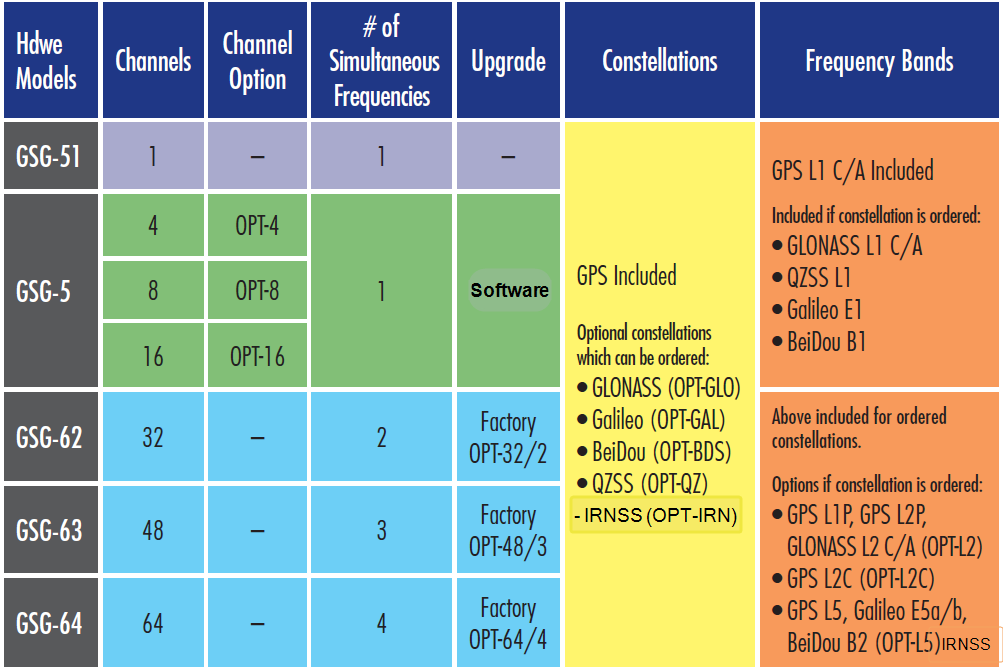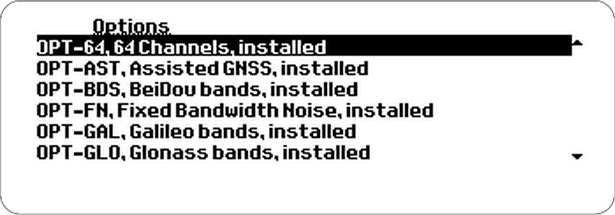GSG Series Model Variants and Options
Orolia GSG Series GNSS constellation simulators and signal generators are available in several different Model configurations, and with numerous Option packages, in order to allow for application-specific customization:

GSG options overview
Which GSG Model & Options Do I Have?
The model will be displayed in the top-left corner of the Main screen (startup screen).
To find out which options are installed on your GSG unit, navigate to Options > Show System Information > Options. Press enter to access this list:

List of installed options
GSG Models & Variants
GSG-51 Series
- Single-Channel GPS Factory Tester
Options for GSG-5:
- GLONASS
- GALILEO
- BEIDOU
- QZSS
- Upgrade to 4-channel unit
GSG-5 Series
- Base unit: 4 channels, GPS L1 C/A
Options for GSG-5:
- Upgrade to 8, or 16-channels
- Upgradable to GSG-6 Series
- SBAS
- Trajectories
- Multipath
- White Noise
- Programmable PPS (1, 10, 100, 1000)
- StudioView software
- Antenna modeling
- Front Panel Lockout
- NTP Synchronization
- Arm and trigger
- Leap Second Simulation
GSG-6 Series
Multi-frequency, Multi-system GNSS constellation simulators:
- Up to 64 Channels and 4 simultaneous frequencies
- GPS L1 C/A
- Includes Advanced Feature Set of GSG-5
GSG-6 Model variants:
-
-62: 32 channels and 2 freq bands
-
-63: 48 channels and 3 freq bands
-
-64: 64 channels and 4 freq bands
Options for GSG-6:
- Upgradeable to 48 channels and 3 simultaneous frequencies, and 64 channels and 4 simultaneous frequencies
- GLONASS, GALILEO, BEIDOU, QZSS, IRNSS
- Add New GPS Signals L2C and L5
- Add GPS and GLONASS L2 (includes P Code on both L1 and L2)
- Add Galileo E5a/b and BeiDou B2
List of Available Options
OPT-04,-08,-16,-32,-48.-64: enables all channels that the GSG hardware can support.
OPT-AST: enables features for Assisted-GNSS testing.
OPT-BDS: enables all BeiDou signals supported.
OPT-ECL: enabling this option loads and enables the predefined scenarios for eCall.
OPT-FN: fixed bandwidth noise
OPT-GLO: enables Glonass signals supported.
OPT-GAL: enables all Galileo signals supported.
OPT-HPWR: High Power Option
OPT-HV: high velocity/altitude enables the simulation of high velocity vehicles.
OPT-INTF: interference option to simulate interference signals. See also Interference signals.
OPT-IRN: enables all IRNSS signals supported.
OPT-JAM: jamming enables the ability to define a point source of interference signals. See Interference signals.
OPT-L2: enables GPS L2P, L1P and GLONASS L2 signals.
OPT-L2C: enables GPS L2C signals.
OPT-L5: enables GPS L5, Galileo 5a/b, BeiDou B2, IRNSS, SBAS L5 signals.
OPT-L6: reserved for Galileo E6 and BeiDou B3.
OPT-MP: allows for the simulation of multipath signals. See also Multipath Signals.
OPT-NOW: uses downloaded Ephemeris and NTP time set to align GSG generator signals with live sky.
OPT-PPS: PPS Output allows for configuring 1/10/100/1000 pulse-per-second output aligned to the GPS on-time point
OPT-QZ: enables the simulation of QZSS signals.
OPT-RP: offers the ability to convert and record GPS data to a GSG scenario to replay the actual route and satellites in view during that route, including power levels.
OPT-RSG: allows GSG to receive trajectory information in real time via SCPI commands.
OPT-RTK: RTK/DGNSS RTK Real time kinematics enables the generation and use of base station information for RTK receivers.
OPT-SBAS: enables the simulation of satellite base augmentation systems (see SBAS Satellites).
OPT-SEN: sensor simulator package generates various sensor type data in response to a query via SCPI command (included with RSG option)
OPT-SPF: Spoofing range compensation
OPT-TIM: timing calibration option offers 10x improvement in the timing accuracy. See also Timing Calibration.
OPT-TLM: sets the TLM word in all messages to all 1’s
OPT-TRAJ: supports receiver trajectories to be used by GSG.
OPT-TRG: external trigger enables the use of an external trigger signal to start scenarios.
OPT-VIS: visibility package allows for using environmental models to test satellite shadowing by vehicles or surrounding.